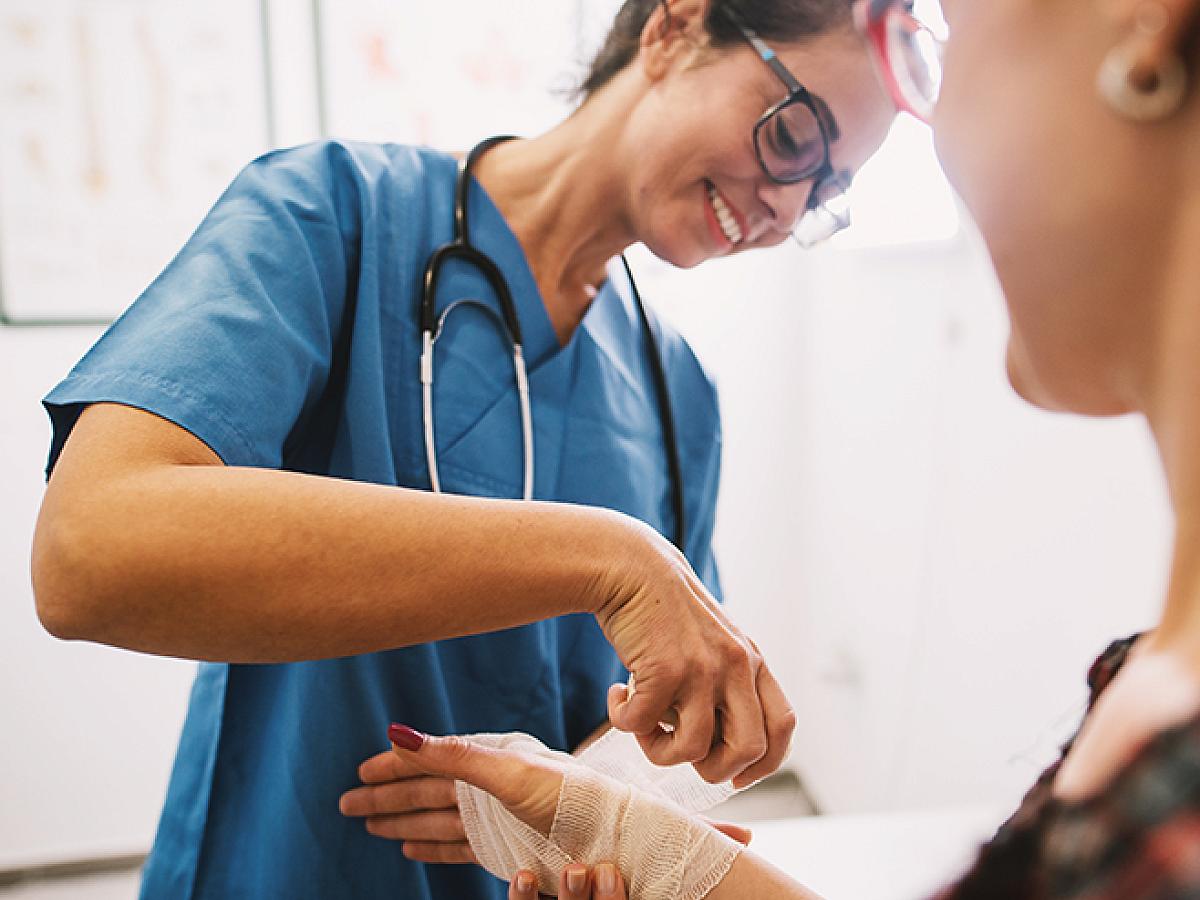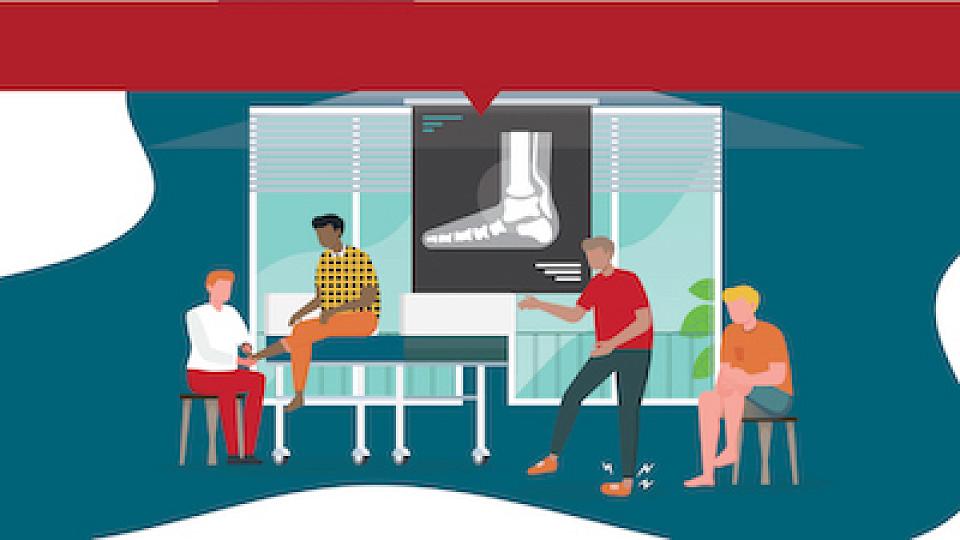
High-Quality Sprain Treatment & Care
Your body has almost 1,000 ligaments—short bands of tough, flexible, fibrous tissue that help hold your bones in place. A sprain is an injury in which the ligament becomes stretched, partially torn, or completely torn. Ligament sprains are common, especially in the ankle and knee. But you can sprain a ligament anywhere in your body, including your wrist, elbow, shoulder, neck, and back.
Why Choose University of Utah Health?
U of U Health provides exceptional care for people with all types of orthopedic injuries, including ligament sprains. Our expert team includes orthopedic surgeons, physiatrists, family medicine physicians, internal medicine physicians, and physical therapists who develop personalized treatment plans that promote healing as quickly as possible.
You can depend on U of U Health for:
- easy access to orthopedic providers. Our specialty care is centered at University Orthopaedic Center, and we also have specialists at our health centers in Farmington, Madsen, Redwood, South Jordan, and Sugar House. All of our practices are fully staffed by a team of specialists and equipped with imaging services.
- access to cutting-edge treatments, novel technologies, and clinical research studies.
- different levels of care, which include emergency and urgent care centers, specialty outpatient clinics, and surgery centers.
- specialized care. Each of our orthopedic specialists has advanced training and experience treating specific areas of the body, such as foot and ankle, knee, shoulder, etc.
Types of Sprains
Doctors describe ligament sprains using the terms grade 1, grade 2, and grade 3.
- Grade 1 sprains are the least serious. They involve a stretched (not torn) ligament and usually go away within one to two weeks using at-home treatment.
- Grade 2 sprains involve a severe stretch and partial tear to the ligament. The healing process takes a bit longer (one or more months).
- Grade 3 sprains involve a fully torn ligament that creates instability in the joint, also known as a ruptured ligament.
Strain vs. Sprain
Sprains and strains are not the same. A sprain affects ligaments, which connect bones to other bones, and a strain affects muscles and tendons (the flexible, fibrous tissue that attaches a muscle to a bone).
Sprain Symptoms
Ligament sprain symptoms vary depending on the injury’s severity (or grade). The more severe a sprain is, the worse the symptoms—including your pain level—will be.
- Grade 1 sprain symptoms include pain and swelling.
- Grade 2 sprain symptoms include pain, swelling, and possibly bruising (if the ligament is torn).
- Grade 3 sprain symptoms include pain, bruising, and swelling. These sprains usually make the joint unstable.
Ligament Sprain Causes
Ligament sprains result from trauma to the ligament. Common causes include a sports injury, car crash, or simply stepping off a curb awkwardly.
When to Seek Medical Care for a Sprain
Seek medical care at the emergency department if:
- you are in severe pain or
- the joint appears to be dislocated.
Seek medical care at an urgent care center or our Orthopaedic Injury Clinic if:
- you can’t manage your pain level with at-home care.
- your symptoms remain the same or worsen after 24-48 hours, even with at-home care.
- the joint feels unstable or “gives out” when you use it.
- the injury affects your ability to do your usual activities, even with RICE and pain medication.
If your need is not urgent, consider making an appointment with an orthopedic specialist at University Orthopaedic Center in Salt Lake City or our neighborhood health centers in Farmington, Madsen, Redwood, South Jordan, or Sugar House.
How to Treat a Sprain at Home
You can manage a minor sprain with treatment at home. For the first 24-48 hours after the injury, doctors recommend the RICE method.
- Rest — Take it easy and avoid putting weight on the injured area.
- Ice — Apply an ice pack to the injured area for 15-20 minutes every two to three hours.
- Compression — Wrap the injured area with a medical bandage (like an ACE bandage). Make sure it is snug but not too tight.
- Elevation — Raise the injured area above the level of your heart whenever possible.
Over-the-counter pain medication such as ibuprofen (Advil, Motrin) and acetaminophen (Tylenol) also can help. Be sure to take as directed on the label.
Ligament Sprain Treatment
Your provider may recommend treatment options such as:
- a splint, sling, or brace to stabilize the joint for a short period of time;
- physical therapy to strengthen the muscles around the injured ligament, which can stabilize the joint and enhance healing;
- surgery to repair the torn ligament;
- an injection of pain relief medication;
- a natural substance called plasma to stimulate healing; or
- ultrasound therapy, which may improve soft tissue healing.
How Long Does It Take for Ligaments to Heal?
Healing time for a ligament sprain varies depending on:
- which joint was injured,
- the severity of the injury, and
- your age, overall health, and activity level.
In general, grade 1 sprains take a few weeks to heal; grade 2 sprains take one or more months; and grade 3 sprains take two to three months (longer if surgery is needed).
Find an Orthopedic Specialist
Emily E. Bigler, PA-C
Orthopaedic SurgeryKristen L. Carroll, MD
Orthopaedic SurgeryWilliam J. Fahrenbach, MPS, PA-C
Orthopaedic SurgeryKaty Y. Fu, MSN, ACNP-BC, DNP
Orthopaedic SurgeryElizabeth A. Graesser, MD
Orthopaedic SurgeryTheodore T. Guild, MD
Orthopaedic Surgery
Resources for Our Patients
What Does an Orthopedic Doctor Do?
If you play sports, are in your 40s or 50s, or have family and friends who are physically active, you’ve probably heard of the word "orthopedics.” But do you know what orthopedic doctors really do? And how do you know if you could benefit from seeing one?
Orthopedic Injury Clinic
At our Orthopedic Injury Clinic, you can get an appointment the day you call. Come to this clinic for fractures, dislocations, or other pains to your bones, joints, or muscles that won't go away.
When to See a Sports Medicine Doctor
Everyone has a body. To take care of it, you’ll need to stay active. But no matter how careful you are, at some point or another, you may injure yourself. Should you see a doctor right away? Or is it better to take it easy and wait for the injury to heal on its own?
What Is Physical Therapy?
Physical therapy helps you improve your function, range of motion, and overall quality of life. It can help speed up healing from an injury, reduce pain, and prevent injury. For some people, physical therapy can significantly delay the need for surgery or help avoid it altogether.







